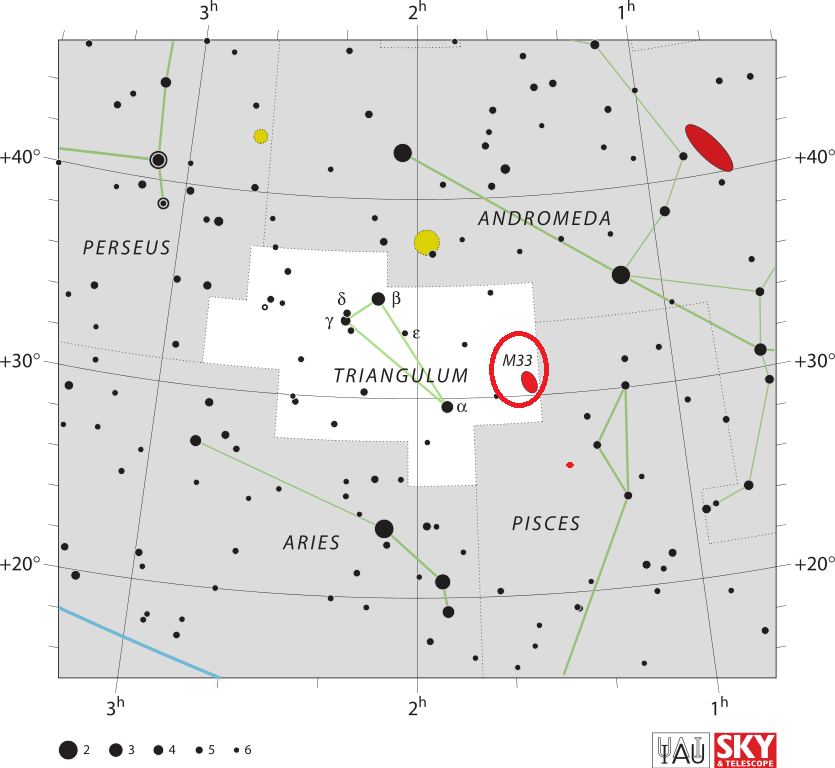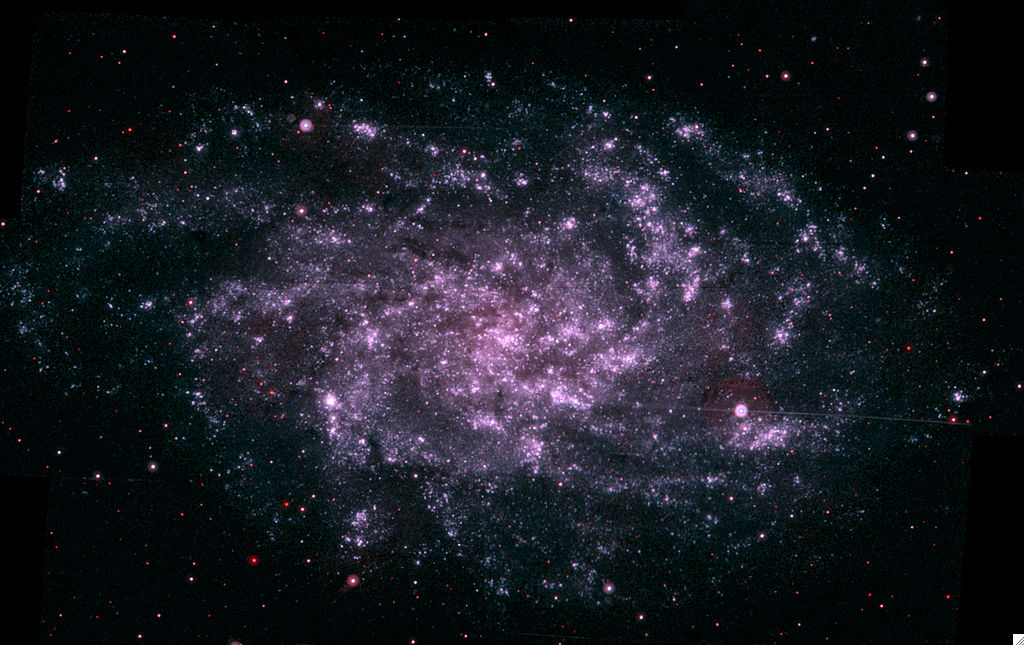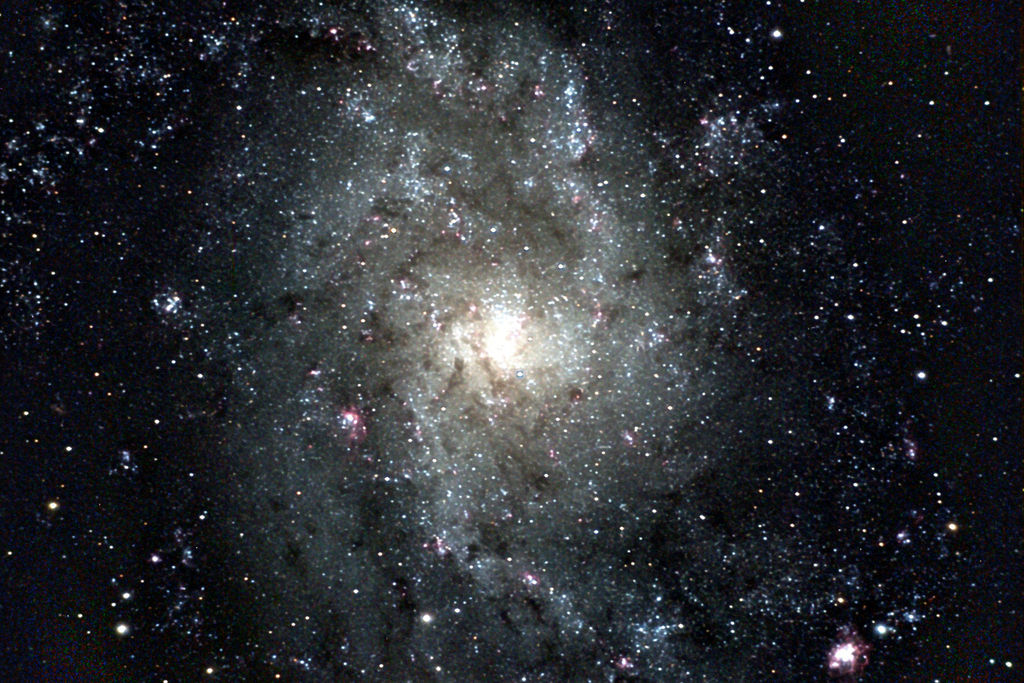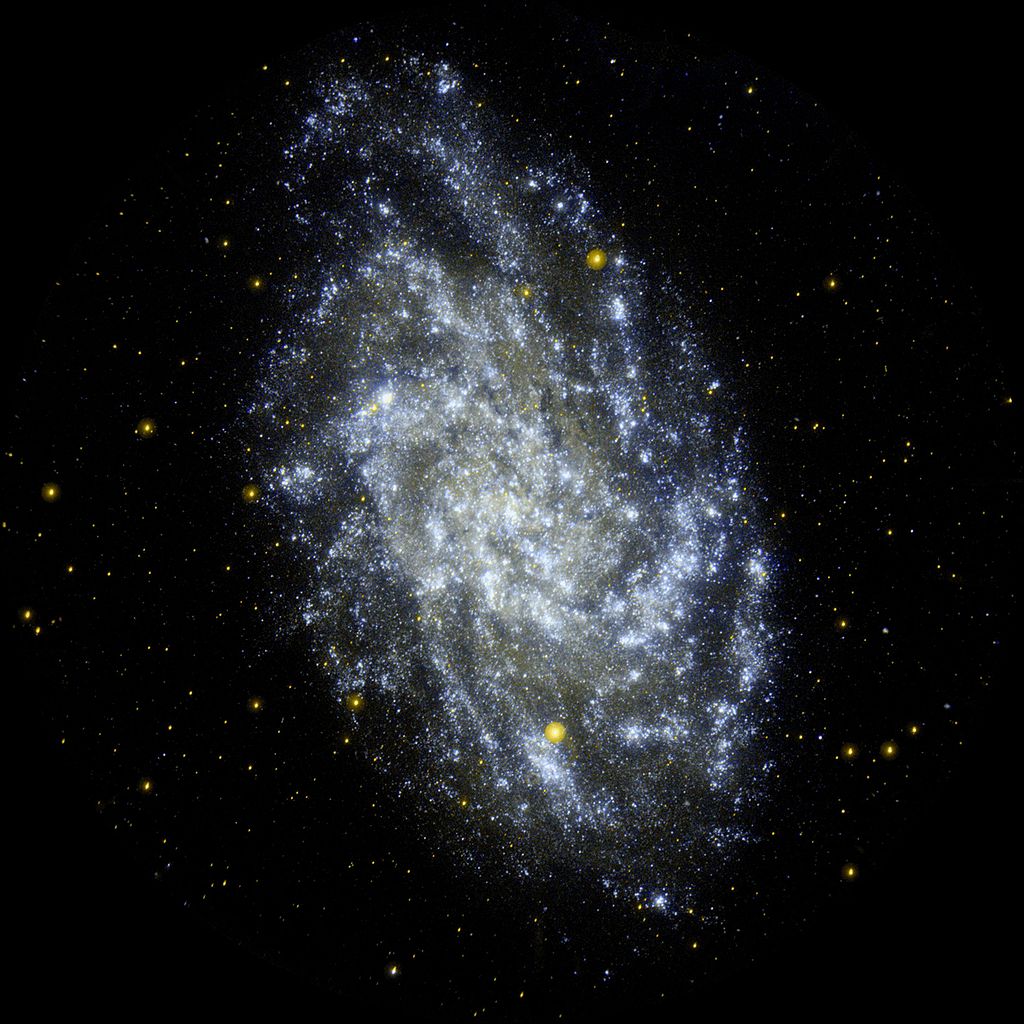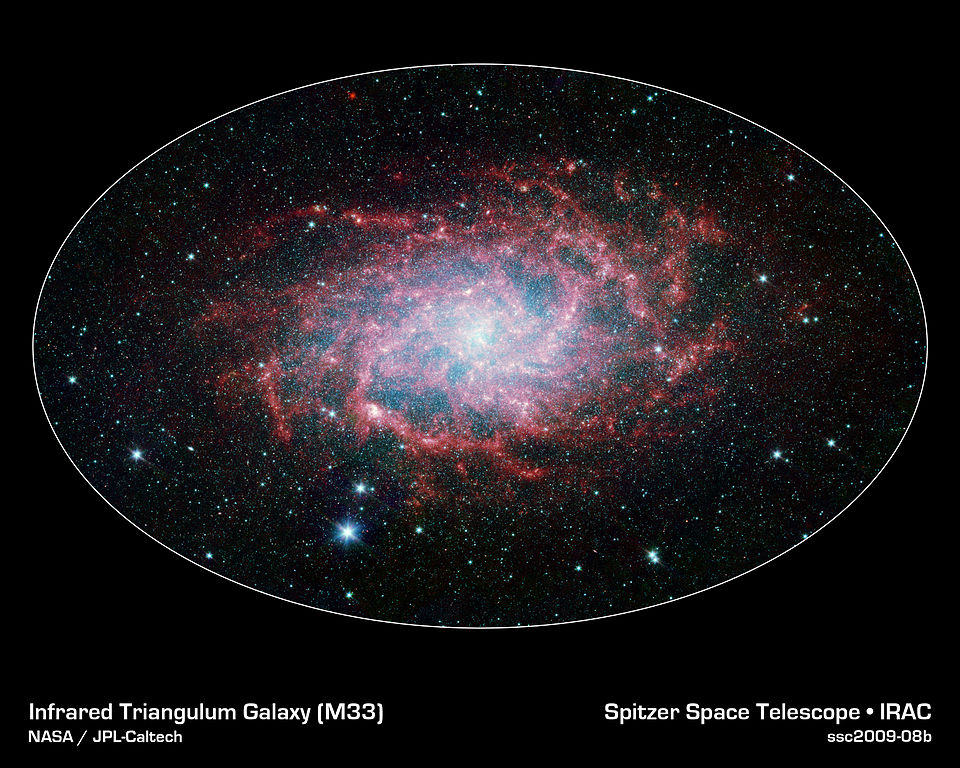Messier 33 (M33), also known as the Triangulum Galaxy, is a famous spiral galaxy located in the small northern constellation Triangulum. The Triangulum Galaxy is the third largest galaxy in the Local Group, after the Andromeda Galaxy and the Milky Way. It is also the second nearest spiral galaxy to the Milky Way and the smallest spiral galaxy in the Local Group.
M33 is one of the most distant permanent deep sky objects visible to the naked eye. The galaxy lies at a distance between 2.38 and 3.07 million light years from Earth and has an apparent magnitude of 5.72. Its designation in the New General Catalogue is NGC 598.
Messier 33 appears face-on when viewed from Earth and has a low surface brightness. It is strongly affected by light pollution and can be a challenge for observers – with or without binoculars or telescopes – in less than perfect conditions.
M33 lies 3.5 degrees to the west-northwest of Mothallah, Alpha Trianguli, the second brightest star in Triangulum, and 7 degrees to the southwest of Mirach, Beta Andromedae, the star that is also used to locate the nearby Andromeda Galaxy.
The Triangulum Galaxy is best seen in very large binoculars or telescopes at low magnifications. It is a popular target for astrophotographers as its spiral arms and brighter H II regions can be captured with better amateur equipment. Large telescopes will reveal the galaxy’s globular clusters, dust lanes and spiral structure itself.
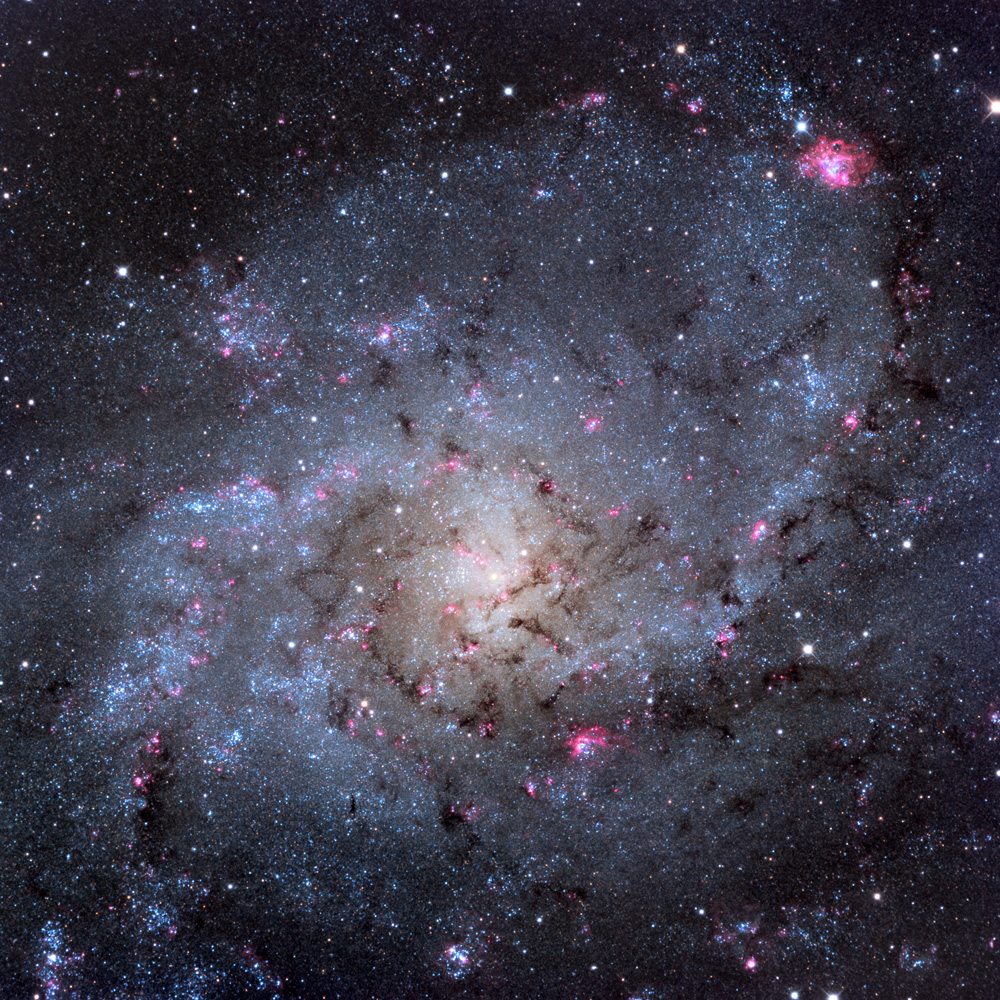
The easiest way to locate M33 is to start with the Great Square of Pegasus (formed by Alpheratz, Scheat, Algenib and Markab) and trace the three bright stars of Andromeda in the direction of Cassiopeia’s W. Mirach is the middle star along the line. A line drawn from Mirach to Mothallah, the star that marks the apex of the triangle in the constellation Triangulum, leads directly to the Triangulum Galaxy. M33 is located just over halfway along the line. The best time of year to observe the galaxy is in the months of October, November and December.
Messier 33 is believed to be a satellite of the larger Messier 31 based on their proximity, interaction and velocities. The two galaxies are separated by less than 300 kiloparsecs. M33 is slightly more distant from us than Andromeda. A stream of hydrogen gas linking M31 and M33 was discovered in 2004 and confirmed in 2011, indicating a past interaction between our two neighbours between 2 and 8 billion years ago. M33 and M31 will likely undergo a more dramatic encounter in about 2.5 billion years.
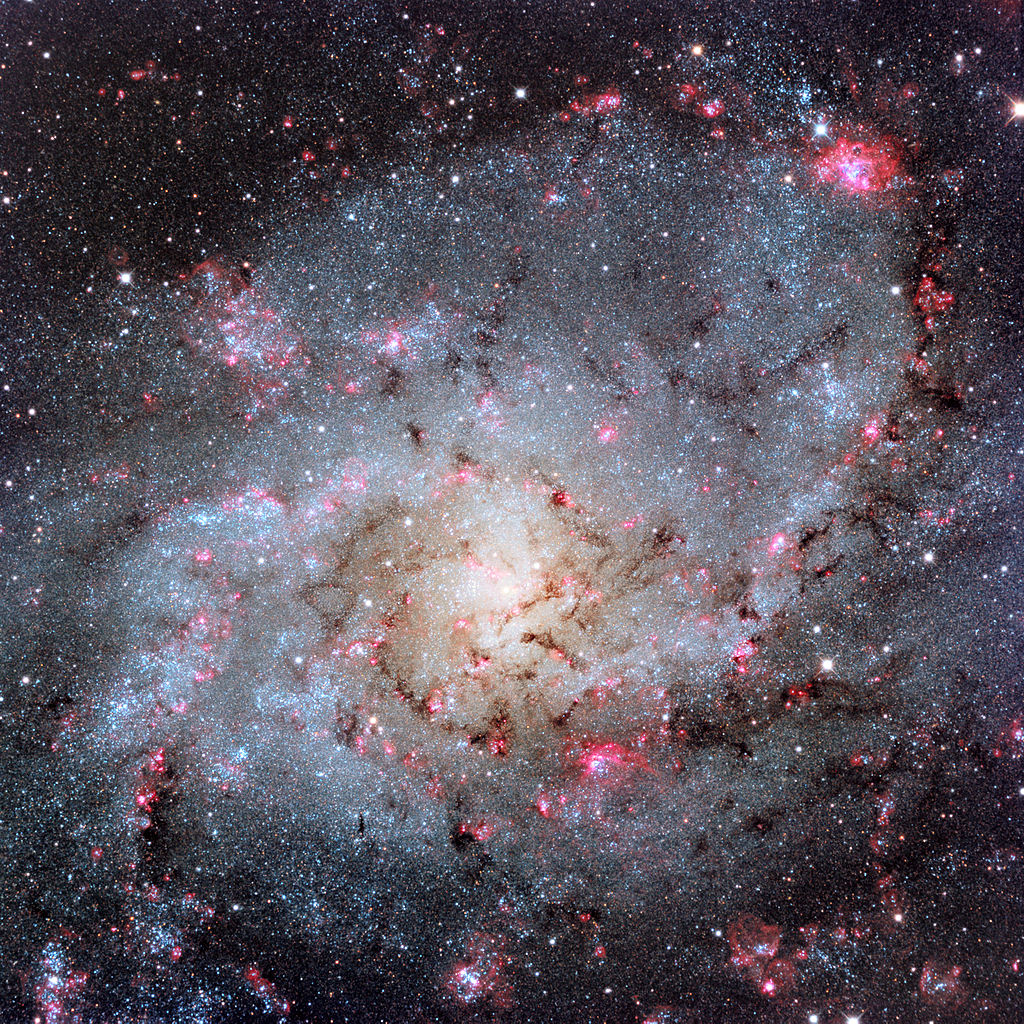
The future of the Triangulum Galaxy cannot be predicted with any certainty, but it is tied to that of the Andromeda Galaxy. M33 will either be absorbed by Andromeda, be part of Andromeda‘s collision with the Milky Way, collide with the Milky Way itself before Andromeda does, or be ejected out of the Local Group of galaxies. The Triangulum Galaxy is currently approaching the solar system at 179 km/s and the Milky Way Galaxy at 24 km/s.
Messier 33 occupies an area of 70.8 by 41.7 arc minutes in size and has a true diameter of about 60,000 light years, slightly more than a half of the Milky Way’s diameter. It appears about 2.5 times larger than the full Moon in the sky. The galaxy contains about 40 billion stars, which is significantly less than the Milky Way (400 billion) and Andromeda Galaxy (1 trillion).
The Triangulum Galaxy has a mass between 10 and 40 billion solar masses. There is no evidence of recent interactions with other galaxies.
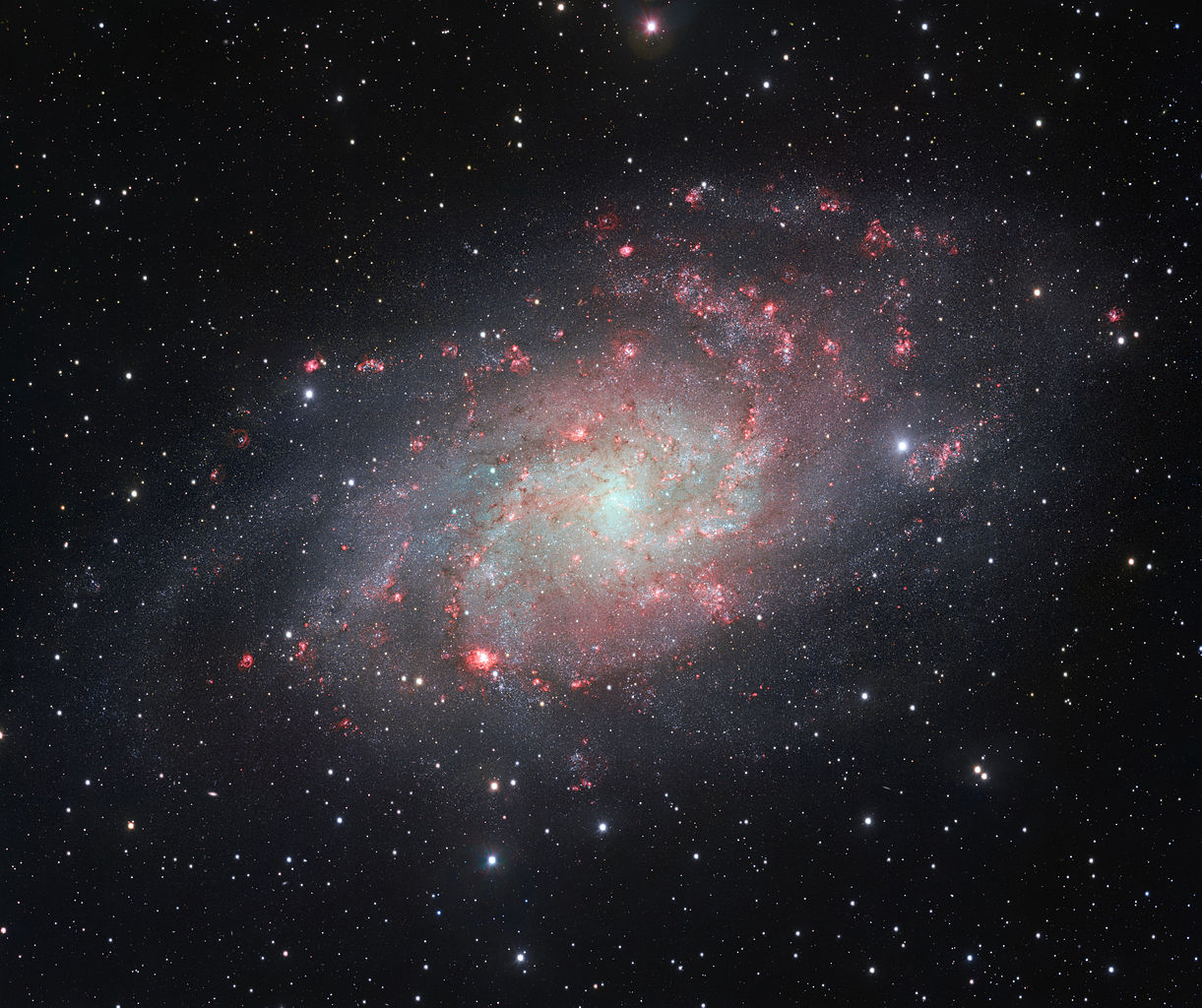
Messier 33 is classified as a type SA(s)cd galaxy, an unbarred spiral galaxy with relatively loosely wound spiral arms emerging directly from the nucleus. It is inclined 54 degrees to our line of sight.
The nucleus of the Triangulum Galaxy is an H II region which contains the most luminous X-ray source in the Local Group. The ultraluminous X-ray source in the core of M33 is modulated by 20 percent over a period of 106 days. The galaxy’s core itself does not seem to contain a supermassive black hole. The central black hole has a mass of up to 3,000 solar masses. The area spanning the central 4 arc minutes of M33 contains vast molecular clouds in which new stars are formed.
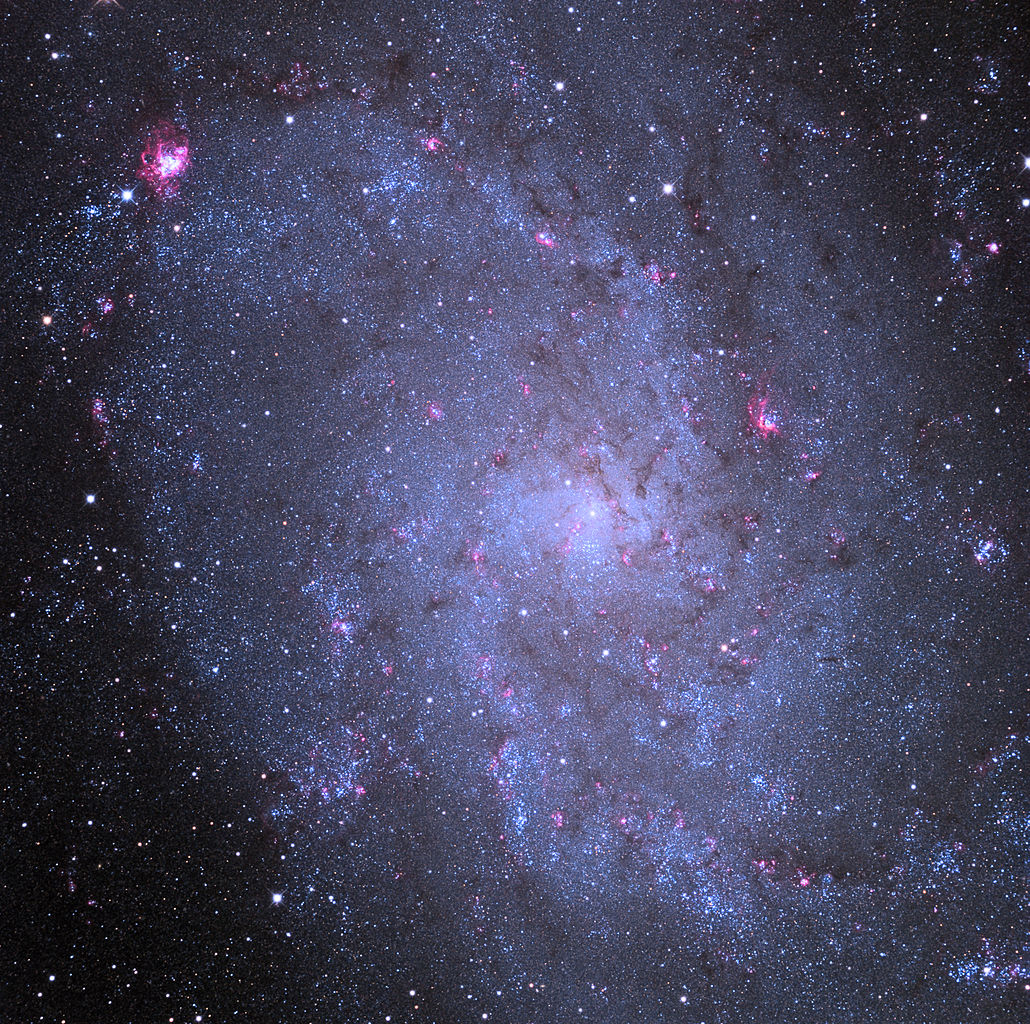
The northern spiral arm of M33 contains four vast H II regions, while the southern arm is more densely populated by hot young stars. On average, there is one supernova explosion every 147 years in the galaxy. 100 supernova remnants have been discovered in M33 so far, most of them in the southern portion of the galaxy.
The Triangulum Galaxy contains at least 54 and possibly up to 122 or more globular clusters. The 54 confirmed globulars are believed to be several billion years younger than those found in the Milky Way.
The largest stellar mass black hole ever found was discovered in M33 in 2007. Named M33 X-7, the black hole has a mass 15.7 times that of the Sun. It orbits and eclipses a companion star every 3.5 days.
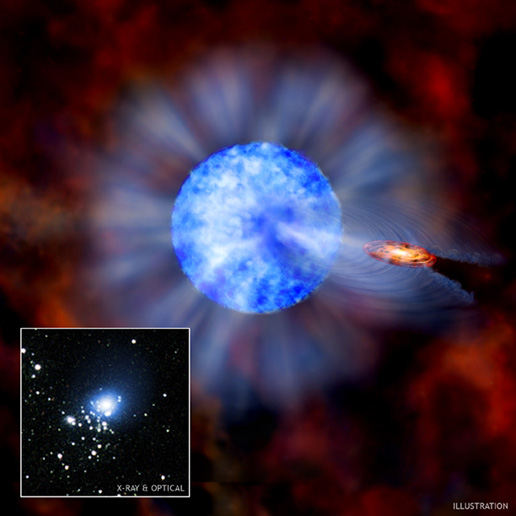
In the illustration, an orange disk surrounds the black hole. This depicts material, fed by a wind from the blue companion star, which has been swept into orbit around the black hole. Rather than flowing unimpeded and uniformly into space, wind from the star is pulled towards the black hole by its powerful gravity. The wind that does make it past the black hole is disrupted, causing turbulence and ripples beyond the disk. The companion star itself is also distorted by the gravity from the black hole. The star is stretched slightly in the direction of the black hole, causing it to become less dense in this region and to appear darker. Illustration: NASA/CXC/M.Weiss; X-ray: NASA/CXC/CfA/P.Plucinsky et al.; Optical: NASA/STScI/SDSU/J.Orosz et al.
The nearby Pisces Dwarf (LGS 3), which lies 20 degrees from Messier 31 and 11 degrees from Messier 33, could be a satellite of either of the two larger galaxies. The Pisces Dwarf is an irregular dwarf galaxy located in Pisces constellation and one of the members of the Local Group of galaxies.
Messier 33 is sometimes known as the Triangulum Pinwheel or Pinwheel Galaxy, a name commonly used for Messier 101, another famous face-on spiral galaxy, located in the constellation Ursa Major. M33 got its name from the area of the sky it occupies, the constellation Triangulum. Triangulum is Latin for “triangle” and refers to the asterism formed by the constellation’s three brightest stars, Ras al Muthallah (Mothallah) or Alpha Trianguli, Deltotum or Beta Trianguli, and Gamma Trianguli. The three stars form a long, narrow triangle, with Alpha Trianguli marking the apex and Beta and Gamma Trianguli at the base.
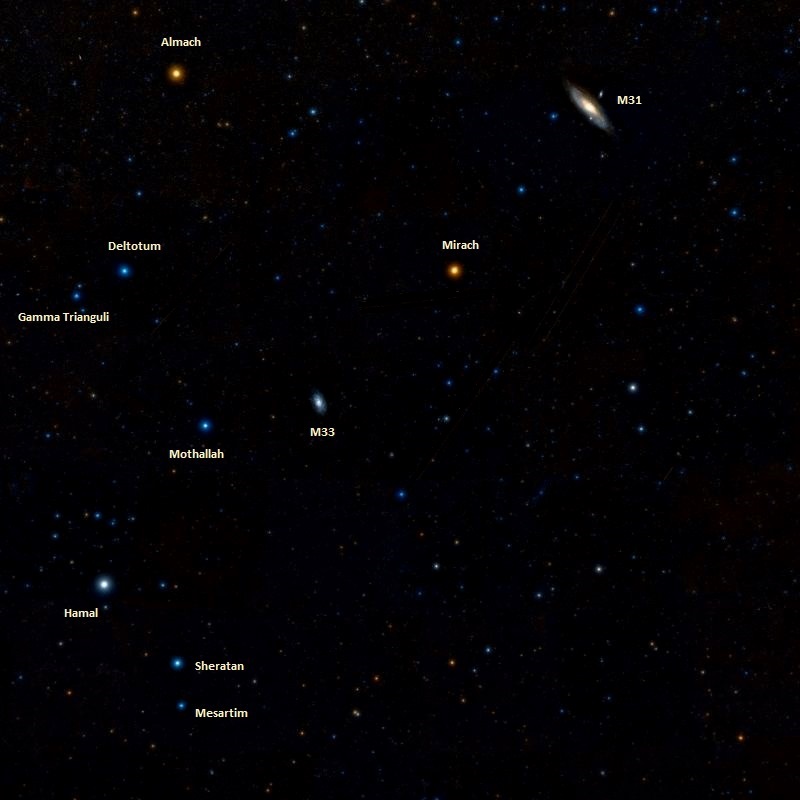
Messier 33 was probably first discovered by the Italian astronomer Giovanni Battista Hodierna before 1654. Hodierna listed the object as a cloud-like nebulosity near “the Triangle” in his work De systemate orbis cometici; deque admirandis coeli caracteribus (“About the systematics of the cometary orbit, and about the admirable objects of the sky”).
Charles Messier found the object independently and catalogued it on August 25, 1764. This is what he wrote in the first Messier catalogue:
In the night of August 25 to 26, 1764, I have discovered a nebula between the head of the northern Fish [of Pisces] & the large Triangle, a bit distant from a star which had not been known, of sixth magnitude, of which I have determined the position; the right ascension of that star was 22d 7′ 13″, & its declination 29d 54′ 10″ north: near that star, there is another one which is the first of Triangulum, described by the letter b. Flamsteed described it in his catalog, of sixth magnitude; it is less beautiful than that of which I have given the position, & one should set it to the rank of the stars of the eighth class [magnitude]. The nebula is a whitish light of 15 minutes in diameter, of an almost even density, despite a bit more luminous at two third of its diameter; it doesn’t contain any star: one sees it with difficulty with an ordinary [non-achromatic] refractor of one foot [FL]. I have compared it to the star Alpha Trianguli, & with that of which I have reported the position. I have found the right ascension of that nebula at 20d 9′ 17″, & its declination of 29d 32′ 25″ north.
William Herschel catalogued M33 as H V.17 after observing it on September 11, 1784. He described the object as a “nebulosity. not less than 1/2 deg. broad, perhaps 3/4 degree long, but not determined.”
After seeing M33 in a 7-foot reflector, Herschel wrote, “There is a suspicion that the nebula consists of exceedingly small stars. With this low power it has a nebulous appearance; and it vanishes when I put on the higher magnifying powers of 278 and 460.”
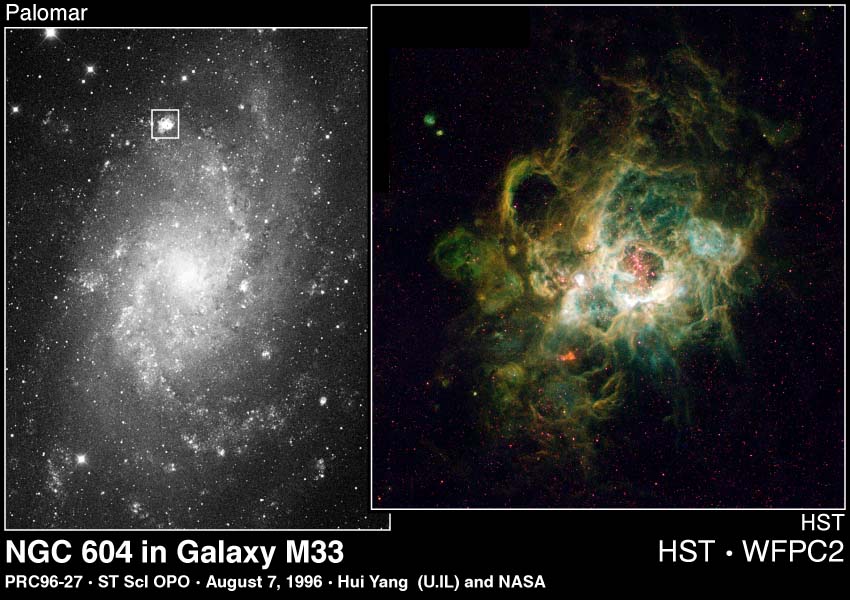
Herschel also listed the largest, brightest H II region in the Triangulum Galaxy as H III.150, which led to the diffuse emission nebula’s inclusion in the New General Catalogue as NGC 604. The nebula lies in the northeastern part of M33 and has a spectrum similar to that of the famous Orion Nebula (M42), but is about 40 times larger than the visible part of M42.
NGC 604 is one of the largest H II regions ever discovered, with a diameter spanning almost 1,500 light years. The Hubble Space Telescope was able to resolve more than 200 massive, hot stars in the nebula with masses in the range from 15 to 60 times that of the Sun.
Other bright star-forming regions associated with giant molecular clouds in the galaxy include NGC 588, NGC 592, NGC 595, IC 132, IC 133 and IK 53.
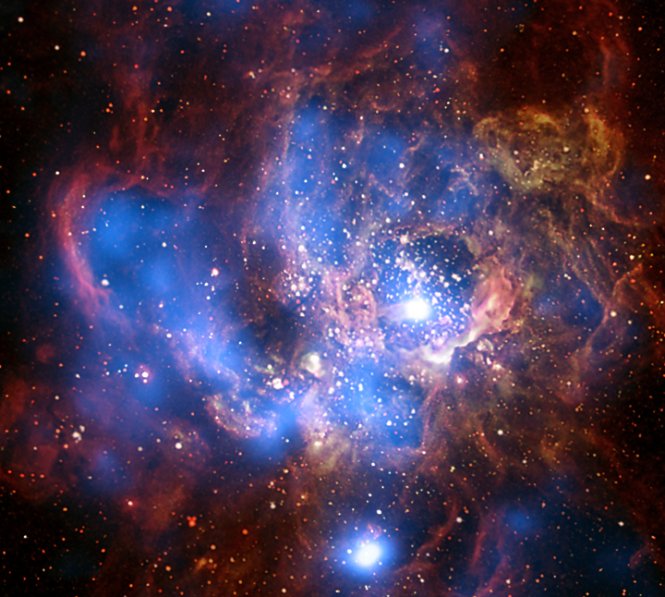
Throughout the cosmic metropolis, giant bubbles in the cool dust and warm gas are filled with diffuse, multi-million degree gas that emits X-rays. Scientists think these bubbles are generated and heated to X- ray temperatures when powerful stellar winds from the young massive stars collide and push aside the surrounding gas and dust. So, the vacated areas are immediately repopulated with the hotter material seen by Chandra. However, there is a difference between the two sides of this bifurcated stellar city. On the western (right) side, the amount of hot gas found in the bubbles corresponds to about 4300 times the mass of the sun. This value and the brightness of the gas in X-rays imply that the western part of NGC 604 is entirely powered by winds from the 200 hot massive stars.
This result is interesting because previous modeling of other bubbles usually predicted them to be fainter than observed, so that additional heating from supernova remnants is required. The implication is that in this area of NGC 604, none or very few of the massive stars must have exploded as supernovas. The situation is different on the eastern (left) side of NGC 604. On this side, the X-ray gas contains 1750 times the mass of the sun and winds from young stars cannot explain the brightness of the X-ray emission. The bubbles on this side appear to be much older and were likely created and powered by young stars and supernovas in the past. A similar separation between east and west is seen in the optical results. This implies that a massive wall of gas shields the relatively quiet region in the east from the active star formation in the west. Image: NASA
William Henry Smyth observed the galaxy in September 1838 and noted:
A large and distinct, but faint pale white nebula, in the precincts of Triangulum, between it and the Northern Fish; with a bright star a little np [north preceding, NW], and five others following [eastward] at the same distance, between which and the object, there is an indistinct gleam of mere nebulous matter. It was discovered by Messier in 1764; and to WH [William Herschel] had a mottled aspect under his seven-foot reflector, in 1783; but afterwards applying a larger telescope, he resolved it into stars – “the smallest points imaginable.” By a method of turning the space-penetrating power of his instrument into a gradually decreasing series of gauging powers, he considered the profundity of this cluster must be of the 344th order: i.e., 344 times the distance of Sirius from the earth. It is No. 131 of H. [John Herschel]’s Catalogue of 1833; and the above place is obtained by differentiating with Alpha Trianguli, from which it is about 4deg, and just north a line run from that star to Delta Andromedae.
The Triangulum Galaxy was one of the first so-called spiral nebulae identified by the Anglo-Irish astronomer William Parsons, 3rd Earl of Rosse in 1850.
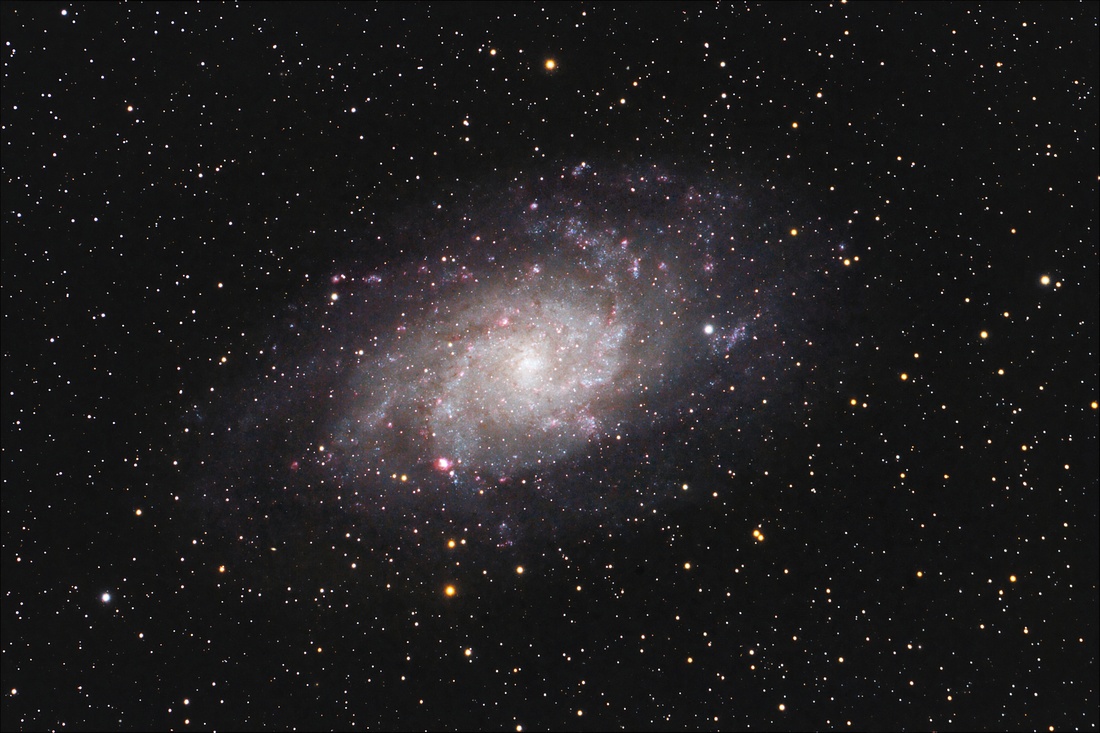
American astronomer Edwin Hubble identified 35 classical Cepheids in M33 in 1926, which allowed him to estimate their distances. The results supported the theory that spiral nebulae were in fact independent galaxies and not just nebulae within the Milky Way.
| Object: Galaxy |
| Type: Spiral |
| Class: SA(s)cd |
| Designations: Messier 33, M33, Triangulum Galaxy, NGC 598, Triangulum Pinwheel, LEDA 5818, 2E 409, PGC 005818, UGC 1117, MCG +05-04-069, 1ES 0131+303, RX J0133.8+3039, RBS 214, TC 906 |
| Constellation: Triangulum |
| Right ascension: 01h 33m 50.02s |
| Declination: +30°39’36.7” |
| Distance: 2.38 to 3.07 million light years (730,000 to 940,000 parsecs) |
| Number of stars: 40 billion |
| Apparent magnitude: +5.72 |
| Apparent dimensions: 70′.8 x 41′.7 |
| Size: 60,000 light years (diameter) |
| Redshift: -0.000607 |
| Helio radial velocity: -179 km/s |
| Galactocentric velocity: -44 km/s |
